
Introduction
YouTube is a powerful platform for real estate agents—but only if you guide viewers on what to do next. A Call-To-Action (CTA) is a prompt telling the audience exactly what step to take, such as download a guide, subscribe, or contact me. Data shows that adding CTAs can significantly boost conversions; videos with a clear CTA see about 23% higher conversion rates than those without (90 YouTube Affiliate Marketing Statistics: Insights, Trends, And More).
In other words, if you’re not leveraging CTAs, you’re leaving leads and future clients on the table. This report outlines the latest data-driven CTA strategies for real estate professionals, with an emphasis on lead magnets (to capture buyer/seller information) and then subscriber growth techniques. We’ll also cover best practices for written, visual, and spoken CTAs, how to A/B test and optimize them, and the psychology (FOMO, social proof, etc.) that makes CTAs truly effective. The goal is to provide practical, actionable tips you can implement in your very next video.
Data-Driven CTA Strategies that Convert
Effective CTAs for realtors are grounded in clear value and specific direction. According to top real estate marketers, clarity is critical: you must guide viewers toward a single desired action and avoid ambiguity (YouTube CTA’s That ConvertWith Guest Mike Sherrard). For example, decide if the primary goal of a video is to capture a lead or to gain a subscriber, and craft the CTA accordingly (don’t ask for everything at once). In fact, using fewer CTAs per video often converts better – one or two key actions at most – because too many requests can dilute the message (How to create effective YouTube CTAs – SocialBee).
If your main goal is lead generation, focus on that (e.g. offering a free resource), and save secondary asks (like “subscribe” or “share”) for another moment (How to create effective YouTube CTAs – SocialBee). On the other hand, if your goal is to grow subscribers, make that CTA the star of the show. Research suggests that without any CTA, viewers may enjoy your content but then move on without engaging further (How to create effective YouTube CTAs – SocialBee). The bottom line: every real estate video should intentionally funnel viewers toward a next step, using data-backed tactics to maximize conversion.
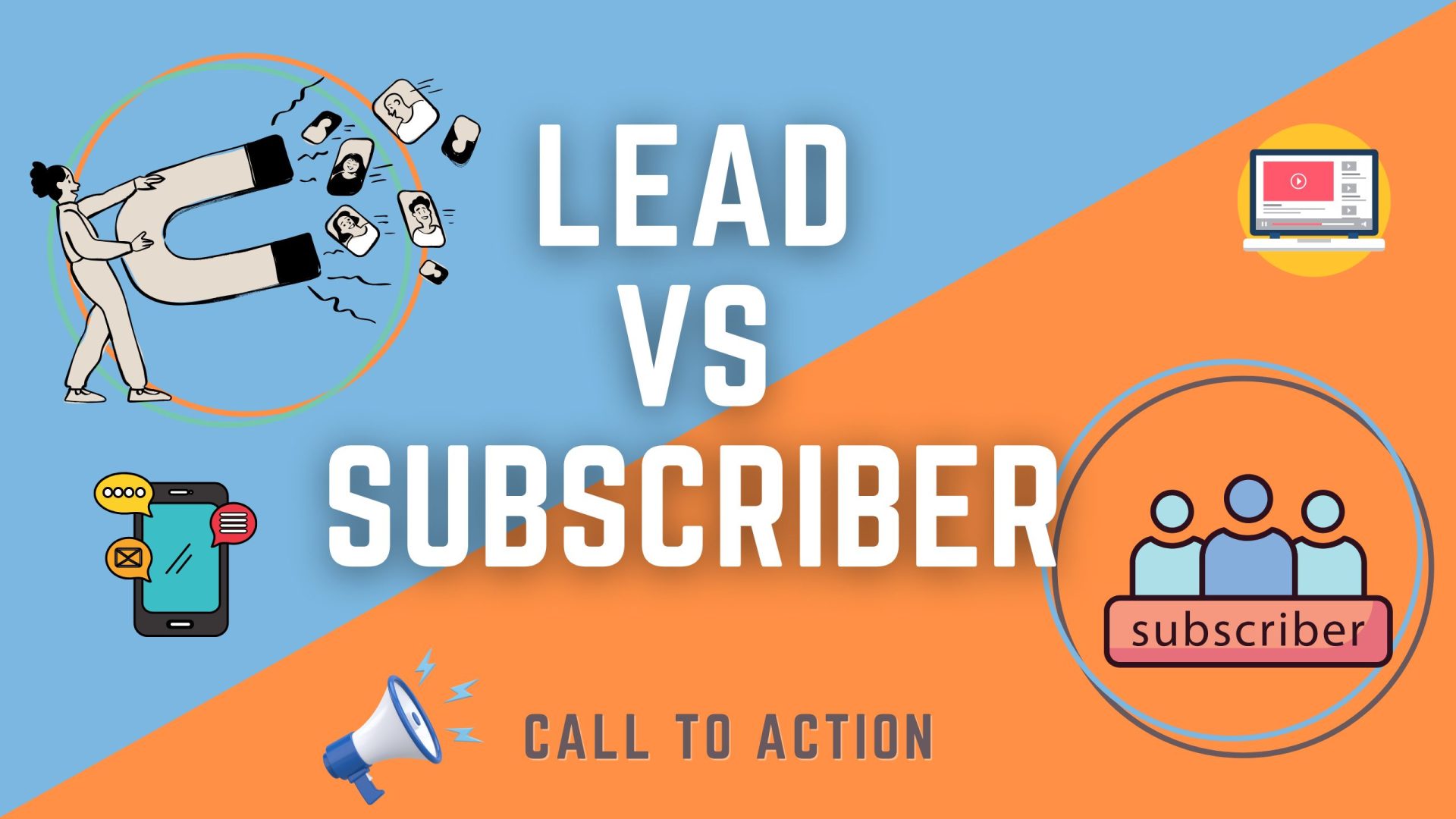
Lead vs. Subscriber CTAs
For real estate agents, CTAs that capture lead information (buyer/seller contacts) tend to have the highest business impact (Perfect YouTube Real Estate Marketing – Jaime Resendiz). Offering something of value in return for a viewer’s email or phone (like a guide or consultation) can turn a casual viewer into a tangible lead. However, subscriber CTAs are also important for long-term channel growth and audience building.
A larger subscriber base means more organic reach for future videos (and thus more potential leads down the line). Best practice is to incorporate both types over time, but prioritize lead-generation CTAs in content aimed at immediate business and use subscriber CTAs to nurture ongoing engagement.
CTAs for Lead Magnets & Information Capture
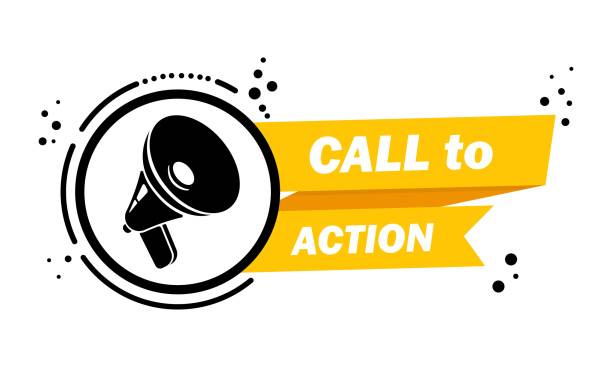
One of the most effective strategies for realtors on YouTube is using lead magnets – free resources that viewers can download or access in exchange for their contact info. This could be a home buyer’s guide, seller’s checklist, neighborhood market report, relocation guide, or similar valuable content. Top agents on YouTube consistently include such offers.
For instance, many “Living in [City]” real estate channels prominently feature a free relocation guide link in the description or pinned comment of their videos. A Florida real estate team’s video description starts with: “Are you considering moving to South Florida? Click here to get a FREE relocation guide:” plus a link to their landing page (The Truth About The Cost Of Living In South Florida! Move Here …).
This kind of CTA immediately provides value and captures warm leads – viewers must enter their email/phone on the agent’s site to obtain the guide, giving the agent a follow-up opportunity.
Real estate YouTuber and coach Jaime Resendiz stresses having a strong call-to-action at the end of each video offering a lead magnet (Perfect YouTube Real Estate Marketing – Jaime Resendiz). He notes that while we’d love viewers to “call us right now,” many aren’t ready to choose an agent on the spot. Instead, give them a compelling reason to leave you their info so you can nurture the relationship (Perfect YouTube Real Estate Marketing – Jaime Resendiz).
For example, you might say on camera: “Before you go, don’t forget to download your Free Homebuyer Guide – it’s linked below. It’s packed with 10 essential tips to save money when buying a home!” This kind of CTA promises specific value and creates a fair exchange (free knowledge for their contact). Resendiz advises ensuring the magnet at least collects name, email, and ideally phone, so you can follow up effectively (Perfect YouTube Real Estate Marketing – Jaime Resendiz).
Examples from top agents
Many top-performing real estate YouTubers use lead-magnet CTAs creatively. One San Diego agent’s channel adds a link to “Schedule a Free 30-minute discovery call” in every description – inviting viewers relocating to book a no-obligation Zoom consultation (What You Should Know Before Moving to San Diego – YouTube). This personal touch converts interested viewers into real appointments. Another agent might offer a “Free Home Value Report” CTA in a video about selling, prompting sellers to visit a website to get their home’s value (and capturing their address and contact in the process).
In community tour videos, a smart CTA is “Request a detailed [City] market report” to get hyper-local leads (41 Real Estate Lead Generation Ideas Using Video Marketing). The key is that these CTAs offer information or help the viewer wants. By solving a problem or answering a question through a lead magnet, you tap into reciprocity – viewers feel you’ve provided value and are more willing to contact you (Effective Call-to-Action Strategies for Paid Advertising| NMQ Digital) (Effective Call-to-Action Strategies for Paid Advertising| NMQ Digital). They also perceive you as an authority (since you literally “wrote the guide” on the topic), which builds trust.
When crafting lead-magnet CTAs, highlight benefits and exclusivity. Use wording that creates urgency or FOMO when appropriate, e.g. “Download your free guide now – available this month only!” or “Limited to the first 50 downloaders.” If a resource is evergreen, you can still stress why they shouldn’t wait: “Don’t miss out on these insider tips that saved my last client thousands – grab the guide below.” By leveraging urgency and scarcity (real or implied), you compel viewers to act promptly (Effective Call-to-Action Strategies for Paid Advertising| NMQ Digital).
Another trick is framing the offer as exclusive: “Join my VIP list to get weekly market updates (subscribers only)” – people love feeling they’re part of an insider group, which can increase response rates (How to create effective YouTube CTAs – SocialBee). Always be clear and direct about how to get the item: e.g. “Click the link in the description” or “Visit the URL on screen now.” Any friction or confusion, and the viewer may abandon the attempt. A data-driven principle is that clarity and simplicity in CTAs reduce drop-off (Effective Call-to-Action Strategies for Paid Advertising| NMQ Digital).
Finally, remember to actually deliver value. The best lead magnet CTAs work because the audience truly wants the thing you’re offering. Do some research on pain points: buyers might want a “Moving to [Your City] Checklist”, investors might want a “Top 5 Neighborhoods for Rental Income” PDF, and homeowners might respond to a “Free Neighborhood Sold Homes Report.”
Make it relevant to the video they just watched. For example, if your video was “5 Tips for First-Time Homebuyers,” a perfect CTA is: “Get my Free First-Time Buyer Starter Kit in the description below”. This feels like a natural extension of the content (aligned CTAs perform best (How to create effective YouTube CTAs – SocialBee)) and will convert higher because it’s contextually relevant.
CTAs for Growing Your Subscriber Base
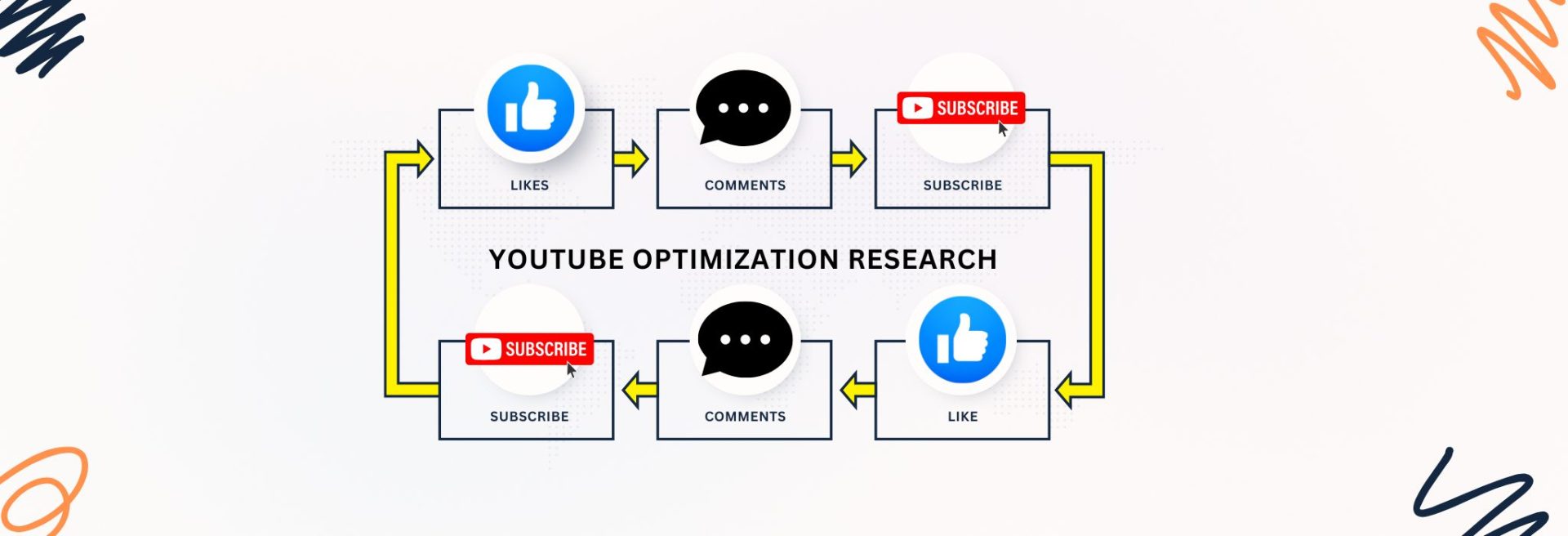
Beyond immediate leads, you should also use CTAs to build your subscriber base. Subscribers are invaluable – they’re essentially a pool of warm prospects who enjoy your content and are likely to engage again. To convert casual viewers into subscribers, you often need to ask, and remind them of the value of subscribing. In fact, most people need a nudge; don’t assume they’ll subscribe on their own (How to create effective YouTube CTAs – SocialBee). A simple verbal prompt like “If you enjoyed this and want more real estate tips, hit Subscribe and the bell icon so you don’t miss our weekly videos” can be highly effective. Notice this phrasing not only instructs the action (subscribe + bell) but also highlights the benefit (“so you don’t miss out”) – tapping into that Fear of Missing Out if they fail to subscribe.
According to YouTube optimization research, you should consistently encourage likes, comments, and subscribes to grow your channel (YouTube Optimization for Real Estate Investors | 10 Proven Strategies). However, how and when you do it matters. Best practice is to avoid placing a subscribe ask in the very first seconds of the video (How to create effective YouTube CTAs – SocialBee). New viewers don’t yet know who you are or why they should subscribe, and an immediate ask can feel off-putting.
Instead, open the video with a strong hook (e.g. “Today I’m showing you three secrets to getting a deal in this market…”). Once you’ve delivered some value or at least hooked their interest, you can introduce a subscribe CTA naturally. For example, after an engaging intro or at a mid-point pause, say: “By the way, if this info is useful, consider subscribing to my channel. I post new home buying tips every week.” This mid-video CTA targets viewers when they’re already invested in the content (often around the retention peak) (How to create effective YouTube CTAs – SocialBee).
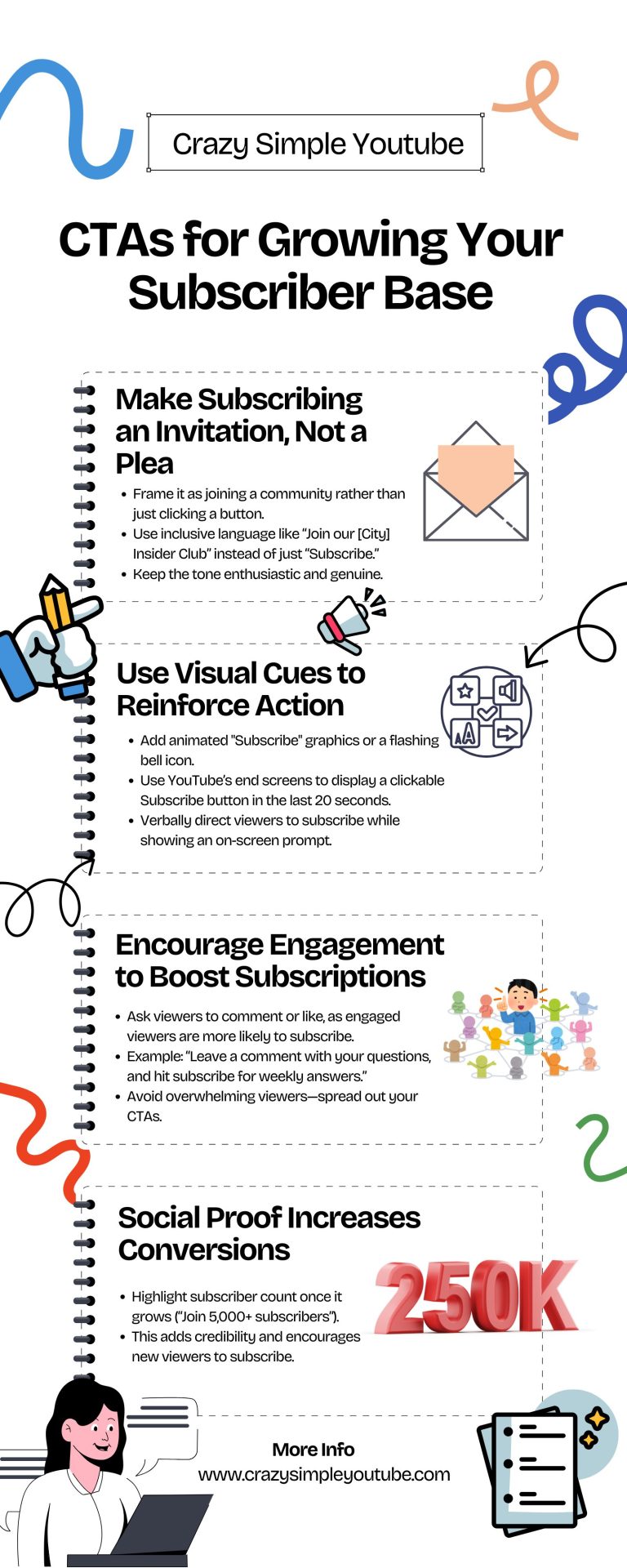
For subscribe CTAs, tone and wording can make a difference. Make it feel like an invitation, not a plea. Some top YouTubers frame subscribing as joining a community: “Subscribe to join our family of Dallas home enthusiasts – we learn and grow together!” This adds an exclusivity or belonging element, as suggested earlier. You might even give your subscriber community a name (e.g. “the [City] Insider Club”) and say “join” instead of “subscribe” (How to create effective YouTube CTAs – SocialBee). Experiment with phrases that resonate with your target audience. Always be enthusiastic and genuine in your delivery – if you sound excited about what’s coming next on your channel, viewers will want to come along.
Don’t forget visual cues for subscribing as well (more on visual CTAs later). Many real estate YouTubers incorporate a quick animated “Subscribe” graphic or a bell icon flash when they mention subscribing. This combination of hearing and seeing the CTA can reinforce action. Also, consider using end screens (YouTube’s built-in end-of-video overlays) to include a Subscribe button viewers can click in the last 20 seconds (YouTube SEO & Channel Optimization Best Practices – Cards & Endscreens (Part 3) | Miles Partnership) (YouTube SEO & Channel Optimization Best Practices – Cards & Endscreens (Part 3) | Miles Partnership). For example, you could end your video with, “Thank you for watching – subscribe here for more 👉” while an end-screen subscribe element appears on screen for easy clicking.
Growing subscribers also ties to encouraging engagement. Often, a viewer who comments or likes is more likely to subscribe because they’ve interacted. So CTAs like “Leave a comment below if you have questions, and hit subscribe for more answers every week” create a one-two punch: engagement and subscription. The YouTube algorithm rewards engagement (comments, likes) which can indirectly boost your visibilit (How to create effective YouTube CTAs – SocialBee) (How to create effective YouTube CTAs – SocialBee)】, so these CTAs serve two purposes. Just be careful not to overwhelm with too many requests at once. You might stagger them: ask for a comment at one point, and a subscribe at another.
In summary, treat your subscriber CTAs as an invitation to join a valuable community or to gain consistent benefits (news, tips, tours, etc.). Be clear, be upbeat, and don’t shy away from reminding viewers – many will act on a subscribe CTA if prompted clearly and at the right time. And as your subscriber count grows, it also becomes social proof (“Join 5,000+ subscribers”) making future CTAs even more compelling.
Best Practices for Written CTAs (Descriptions & Pinned Comments)
Video Descriptions
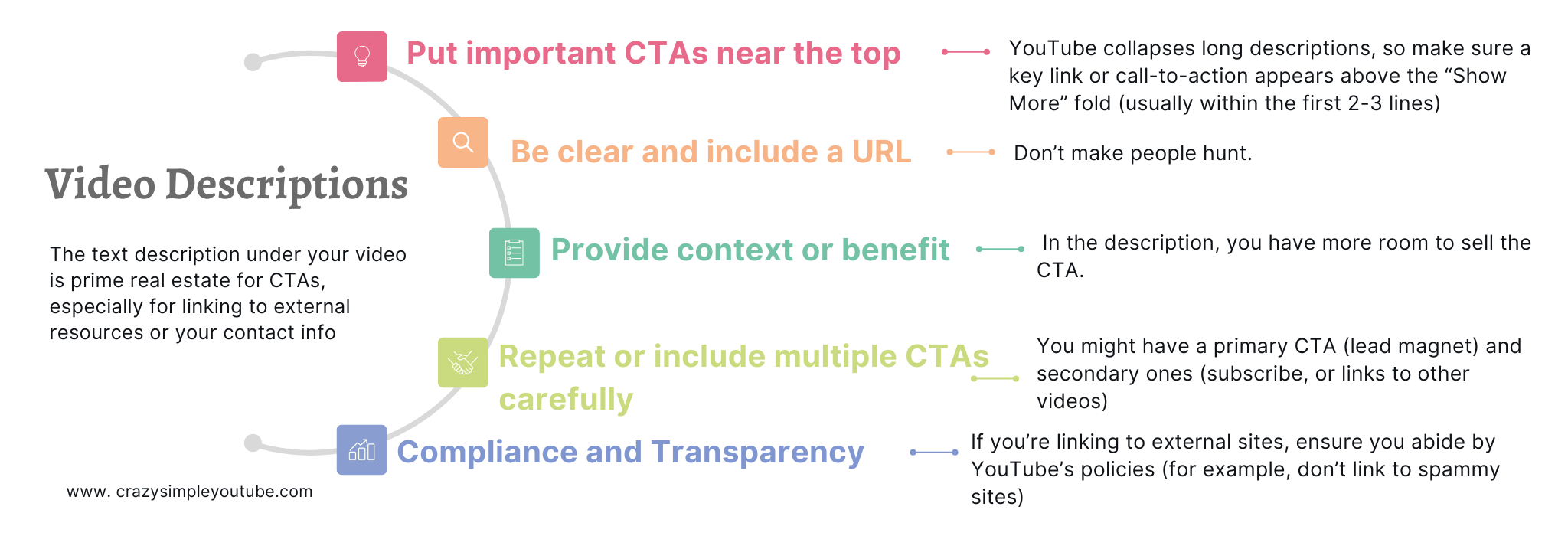
The text description under your video is prime real estate for CTAs, especially for linking to external resources or your contact info. Best practices for written CTAs in descriptions include:
- Put important CTAs near the top: YouTube collapses long descriptions, so make sure a key link or call-to-action appears above the “Show More” fold (usually within the first 2-3 lines). For example, open with a one-liner CTA like “📩 Free Buyer Guide – Download yours here: [link]” before you write a longer video summary. This way, anyone who expands the description immediately sees the CTA. Many agents use emoji or all-caps to make the CTA line stand out visually.
- Be clear and include a URL: Don’t make people hunt. Write something like “Get the Neighborhood Tour PDF ➡️ [YourLandingPage.com]”. Always include the “http://” or “https://” so that the text becomes a clickable hyperlink on YouTube. If the link is long or not branded, use a short link or custom URL. For tracking, you might use a unique URL (or UTM parameters) for YouTube so you know how many leads come from that specific video’s description link.
- Provide context or benefit: In the description, you have more room to sell the CTA. One format that works well is a brief hook sentence + link. For instance: “🏡 Moving to Charlotte? Grab our FREE relocation guide for schools, neighborhoods, and home prices. Download here: [link]”. This not only has the link but also quickly states why they should click it. Keep it concise and action-oriented (“grab,” “download,” “sign up,” etc. – use strong ve (Effective Call-to-Action Strategies for Paid Advertising| NMQ Digital)26】).
- Repeat or include multiple CTAs carefully: You might have a primary CTA (lead magnet) and secondary ones (subscribe, or links to other videos). It’s okay to include a few links, but don’t overload the description with a dozen unrelated links. Stick to a hierarchy: e.g. first link = your main lead magnet or website, second = subscribe link or social media, etc. The description can also mention your contact: e.g. “📞 Questions? Call me at 123-456-7890” – a direct ask for contact can catch those who are ready now. Just format it neatly so it’s easy to find.
- Compliance and Transparency: If you’re linking to external sites, ensure you abide by YouTube’s policies (for example, don’t link to spammy sites). For lead capture pages, it’s best to link to your own website or a trusted landing page where you control the content. Also consider adding a brief privacy note if appropriate (e.g. “we never spam you”) near the CTA to build trust.
Pinned Comments
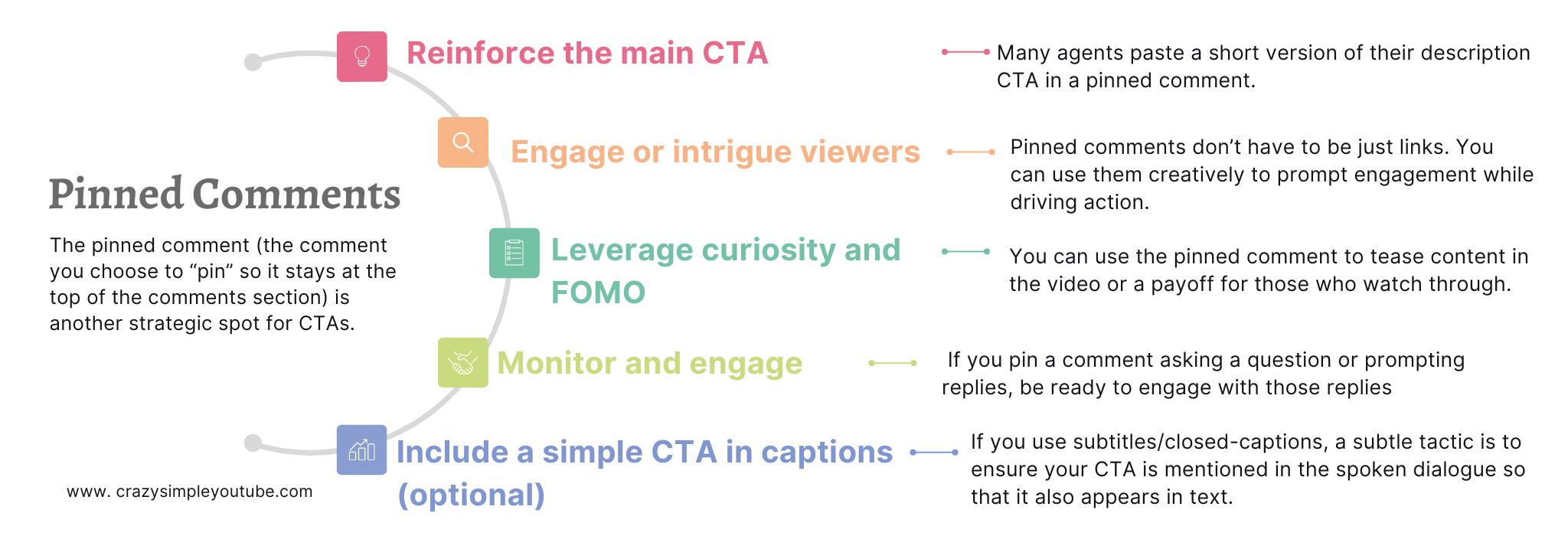
The pinned comment (the comment you choose to “pin” so it stays at the top of the comments section) is another strategic spot for CTAs. This appears very visibly, especially on mobile. Some best practices and ideas for pinned comment CTAs:
- Reinforce the main CTA: Many agents paste a short version of their description CTA in a pinned comment. For example: “📢 Free Home Seller Packet: Get our 10-step seller checklist here 👉 [link]” as a pinned comment ensures even those who don’t check the description see the offer. Pinned comments can be edited anytime, so you can update CTAs or fix links easily.
- Engage or intrigue viewers: Pinned comments don’t have to be just links. You can use them creatively to prompt engagement while driving action. For instance, a pinned comment might say: “💬 What do you think of these tips? Let me know below! Plus, if you want all my first-time buyer tips in one place, grab the free guide in the description 👍”. This both encourages a comment (boosting engagement) and mentions the CTA. One pro tip is to pose a question or “challenge” to the audience in the pinned comment that ties into (The power of pinned comments for YouTube videos – AIR Media-Tech) (The power of pinned comments for YouTube videos – AIR Media-Tech)L78-L86】. For example: “Thinking about moving to Austin? What’s your biggest question? Ask below – and don’t forget to download our Austin relocation kit (free) if you haven’t already!”.
- Leverage curiosity and FOMO: You can use the pinned comment to tease content in the video or a payoff for those who watch through. A famous example (from outside real estate) is a pinned comment by a creator saying “Stop scrolling and watch the video! You want to see the $1,000,000 night hotel at the end haha”. This kind of comment (see figure below) hooks the viewer to actually watch the who (The power of pinned comments for YouTube videos – AIR Media-Tech) (The power of pinned comments for YouTube videos – AIR Media-Tech)93-L100】. A realtor could do something similar: “Stick around to the end of this tour – the last home will blow your mind! 🏰”. While this example isn’t a lead magnet, it’s a CTA to increase watch time, which can indirectly improve conversions by getting people more invested (and thus more likely to click your links after wat (The power of pinned comments for YouTube videos – AIR Media-Tech)ed_image】 Example of a pinned comment used as a call-to-action to keep viewers engaged. This top comment, highlighted by the creator, urges viewers to “stop scrolling and watch the video” and teases a reward (seeing a $1,000,000/night hotel) if they stay unti (The power of pinned comments for YouTube videos – AIR Media-Tech) (The power of pinned comments for YouTube videos – AIR Media-Tech)L93-L100】. Creative pinned CTAs like this leverage curiosity and FOMO to boost watch time and engagement.
- Test different approaches: Pinned comments are easy to change, so you can experiment. One week, pin a link to your newsletter; another week, pin a question to spark discussion. You can then see which video got more responses or link clicks. In fact, treating pinned comments as A/B test elements is a smart (The power of pinned comments for YouTube videos – AIR Media-Tech) (The power of pinned comments for YouTube videos – AIR Media-Tech)239-L247】. For example, on one video your pinned comment CTA might be “Download the market report,” and on another similar video you pin “Schedule a call with me.” If you notice one type gets a better response, you’ve learned something for future videos.
- Monitor and engage: If you pin a comment asking a question or prompting replies, be ready to engage with those replies. The pinned comment can become a hub of discussion. The more you reply to commenters, the more visible and lively that thread becomes, which can encourage even more people to take action (since they see an active community). Also, trolls or spam can sometimes target pinned comments since they’re prominent – keep an eye and moderate as needed to maintain a positive tone.
- Include a simple CTA in captions (optional): (Regarding “captions” in the prompt, we interpret this as on-video captions or subtitles.) If you use subtitles/closed-captions, a subtle tactic is to ensure your CTA is mentioned in the spoken dialogue so that it also appears in text. For example, when you say “link in description,” that will show up on screen for viewers reading captions, which reinforces the message. Some creators even add an extra caption line at the very end like “[Subscribe for weekly videos]” as part of the video’s outro text. However, don’t rely on captions alone for CTAs – not all viewers use them. Think of it just as an additional layer of clarity for those who do.
Best Practices for Visual CTAs (Overlays, Cards, End Screens, Thumbnails)
Visual CTAs are cues within or around your video that prompt action using graphics or interactive elements. YouTube provides built-in tools (cards, end screens) and you can also edit your video to include text/banners. Here’s how to make the most of them:
- Info Cards (YouTube Cards): These are the small clickable pop-ups (the little “ℹ️” icon that slides out) that can link to another video, playlist, or approved external link. Use cards strategically to direct viewers without pulling them out of the e (YouTube SEO & Channel Optimization Best Practices – Cards & Endscreens (Part 3) | Miles Partnership) (YouTube SEO & Channel Optimization Best Practices – Cards & Endscreens (Part 3) | Miles Partnership)†L64-L72】. For real estate, you might add a card at a relevant moment – e.g., when mentioning a neighborhood or past video, a card pops up “Watch: Our Full Tour of [Neighborhood]”.
You can also link to an external site (like your property search page or lead magnet) if you’re part of the YouTube Partner Program and have that feature enabled. Timing is key: it’s best to time a card to when you verbally mention it or when it fits the (YouTube SEO & Channel Optimization Best Practices – Cards & Endscreens (Part 3) | Miles Partnership)†L75-L83】.
For example, “…and I have a checklist of these tips, just click the link popping up on your screen now” (with a card linking to your checklist landing page). Also, check your
audience retention graph – placing a card right at the average drop-off point can sometimes catch people before they leave, by suggesting another video or action when their attention might be (YouTube SEO & Channel Optimization Best Practices – Cards & Endscreens (Part 3) | Miles Partnership)†L79-L83】. Don’t overload a video with cards; a couple per video at most, focused on your main goals.
- On-Screen Graphics/Overlays: These include any text or image you edit directly into the video. For instance, a lower-third banner that appears at the bottom saying “Subscribe for weekly home tours!” or a bubble that says “➡️ Download guide – link in description”. These can be very effective because they catch the eye without the viewer needing to move their mouse. Make sure any overlay text is readable (clear font, adequate size, on screen long enough).
Many agents use tools like Canva or their video editor to create a short banner that slides in at the moment they mention a CTA verbally. Keep it concise; e.g., show a graphic of a PDF icon + “Free Guide – link below”. Visual reinforcement helps, as people remember images. However, avoid clutter or anything that covers important visuals of your home tour. Place overlays in the title-safe areas (usually bottom or top).

- End Screens: End screens are the elements you can set to appear in the last 5–20 seconds of your video, typically to promote other videos or encourage (YouTube SEO & Channel Optimization Best Practices – Cards & Endscreens (Part 3) | Miles Partnership)†L84-L92】. Always utilize end screens – they give viewers who made it to the end something to do next instead of just leaving.
A common end screen setup for real estate channels is:
one subscribe circle and two video thumbnails (maybe one for a playlist like “Home Buying Tips” and one for a specific video you want to highlight). If lead capture is a goal, you could also use one of the end screen elements for a link to your website or landing page (YouTube allows linking an end-screen element to an external site, if your account is eligible). When designing your video content, leave some blank space or an outro segment so the end screen graphics don’t cover your face or impor (YouTube SEO & Channel Optimization Best Practices – Cards & Endscreens (Part 3) | Miles Partnership)†L91-L98】.Typically, agents will have an outro slide (like a branded image or just them on camera saying thanks) for ~15 seconds with room on the sides for these elements.
Call out the end screen in your speech: e.g., “Watch this video next to learn about getting a mortgage” while pointing on screen – and that suggested video is appearing as an end screen element. Remember, viewers who watched till the end are highly interested; an end screen can channel that interest into another video or a subscr (YouTube SEO & Channel Optimization Best Practices – Cards & Endscreens (Part 3) | Miles Partnership)L98-L106】. (End screens can’t run during the same time as a card, so plan them for the very end ex (YouTube SEO & Channel Optimization Best Practices – Cards & Endscreens (Part 3) | Miles Partnership)L92- (How to create effective YouTube CTAs – SocialBee)ed_image】Example of a YouTube end screen highlighting a “Subscribe” prompt (top center) and clickable video thumbnails (in red boxes) to encourage viewers to continue watching related content. End screens appear in the last 5–20 seconds of a video and can include up to four elements, such as subscribe buttons or vi (YouTube SEO & Channel Optimization Best Practices – Cards & Endscreens (Part 3) | Miles Partnership) (YouTube SEO & Channel Optimization Best Practices – Cards & Endscreens (Part 3) | Miles Partnership)L98-L106】. It’s good practice to design your video outro to accommodate these elements without obscuring important visuals.
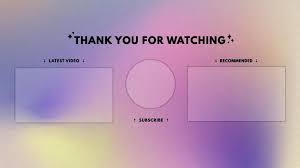
- Thumbnails: While thumbnails are technically outside the video content, they play a HUGE role in driving clicks (and thus getting people to even see your CTA). Think of the thumbnail as the first CTA – it’s a visual call-to-action to “watch me!”. For real estate agents, a compelling thumbnail can make your video stand out among many home tour or advice videos. Best practices: use custom thumbnails with bright, high-contrast imagery (How to Grow with Real Estate YouTube Marketing in 2025: Complete Guide)†L13-L21】. YouTube reports that 90% of top-performing videos use custom t (How to Grow with Real Estate YouTube Marketing in 2025: Complete Guide)†L13-L16】.
Include a short text or headline on the thumbnail that creates curiosity or promises value (e.g., “
5 Homebuyer Hacks” or “Don’t Move to LA Without This”). For a home tour, you might highlight a stunning photo from the home with text like “$500K Home Tour” or “Inside a Luxury Condo”. Faces also work well – if you’re comfortable, include your smiling face reacting (people connect with faces). Ensure the text is readable even as a small image.The thumbnail should accurately represent the video but also
spark interest – this isn’t about clickbait, but about highlighting the most interesting aspect to draw viewers. Creating consistency in style (using the same fonts/colors or a small logo on your thumbnails) can also build recognition (How to Grow with Real Estate YouTube Marketing in 2025: Complete Guide) (How to Grow with Real Estate YouTube Marketing in 2025: Complete Guide)†L31-L34】.
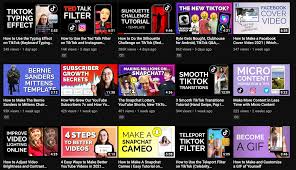
- Visual Branding and Pop-ups: Some agents use branded pop-up animations – for example, a small version of their logo or tagline appearing at the start or end of the video, sometimes with a call-to-action like “Follow us on Instagram @YourHandle” or “Visit our site for listings”. These can reinforce your brand and cross-promote, but use them sparingly so as not to distract. One or two quick branded CTAs per video is fine.
- Timing and duration: For visual CTAs that you insert (like text overlays), don’t make them too fleeting. If you flash “Subscribe” for only a second, viewers might miss it. A good rule: have it on screen while you’re also talking about it, plus a second or two extra. For end screen elements, you ideally want them up for a full 15-20 seconds (so set your end screen duration accordingly). Cards only show briefly unless clicked, so consider reminding verbally that “there’s a link on your screen” so people notice the card.
- Mobile considerations: A large portion of YouTube traffic is on mobile. Cards and end screens do work on mobile (end screens become tappable regions, subscribe buttons appear as well). Thumbnails are of course seen by everyone. Make sure any text you put on screen (in-video) is not tiny or too close to the edges (it could get cut off on mobile or by YouTube’s UI). Using YouTube’s preview tools for end screens can help ensure everything looks good on different devices.
In essence, think of visual CTAs as billboards inside your video – they should be eye-catching, easy to understand at a glance, and well-timed. When you combine a strong spoken CTA with a well-placed visual element, you double the chances that viewers will notice a (How to create effective YouTube CTAs – SocialBee)ed_image】
Example of a visual + spoken CTA encouraging viewers to subscribe and click the bell icon for notifications. This clip shows a channel prompting the audience with on-screen graphics (a bell icon and subscribe banner on the right) while the narrator says “subscribe to our channel and click the bell.” Clear visuals like this reinforce the verbal CTA and highlight the benefit – never missin (YouTube Optimization for Real Estate Investors | 10 Proven Strategies) (YouTube Optimization for Real Estate Investors | 10 Proven Strategies)238-L246】. Such combined prompts can significantly boost subscriber conversion rates.
Best Practices for Spoken CTAs (Verbal Prompts & Scripting)
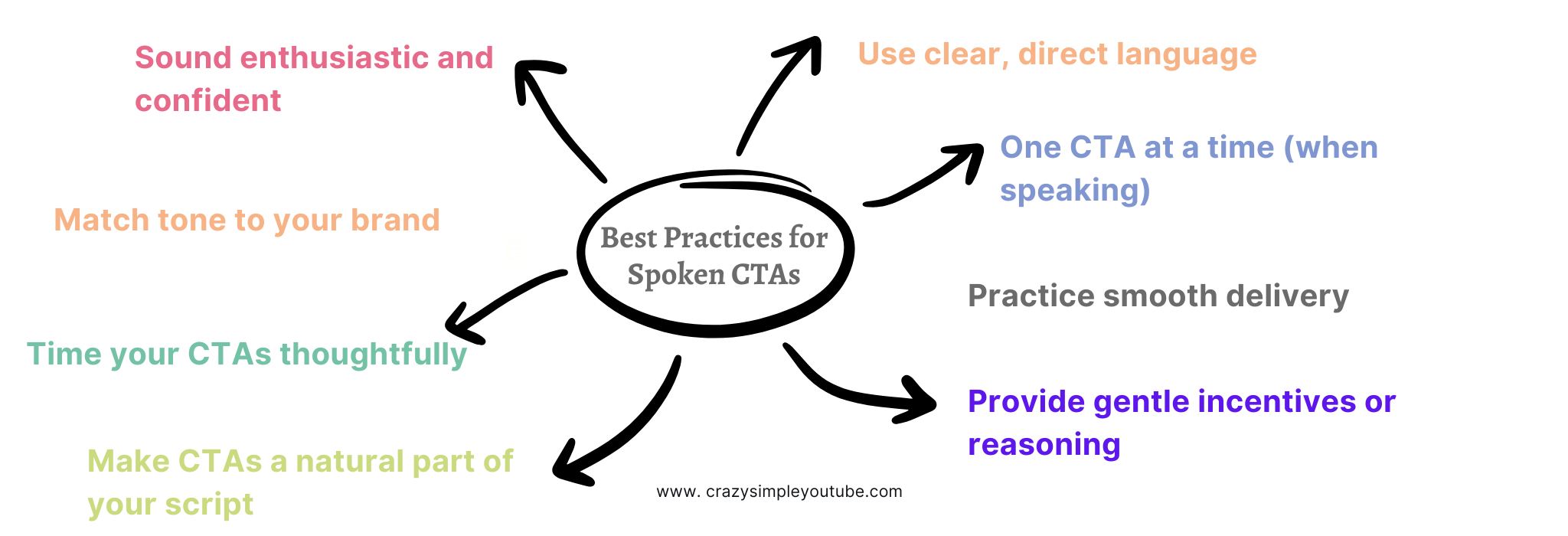
Your spoken delivery of CTAs is just as important as where you place them. As the host of the video, your voice and instructions guide the viewer. Here’s how to make verbal CTAs most effective:
- Sound enthusiastic and confident: If you mumble or rush through a CTA, viewers will tune it out. Deliver your call-to-action with the same energy and clarity as the rest of your content. Show that you believe in the value you’re offering. For example, “I want you to have this checklist—it’s helped so many of my clients. Download it below!” said with a smile and conviction will resonate more than a monotone “you can download a checklist if you want…”. Confidence also conveys that you’re an authority (people are more likely to follow instructions from someone who sounds like they know what they’re doing).
- Time your CTAs thoughtfully: As mentioned, avoid the very beginning for heavy CTAs. Typically, mid-video and end-video are prime times. A useful formula is: introduce a minor CTA mid-way (like asking for a like or comment when something interesting happens), and save the major CTA (lead magnet or subscribe ask) for the end after delivering the promise (How to create effective YouTube CTAs – SocialBee) (How to Grow with Real Estate YouTube Marketing in 2025: Complete Guide)265-L272】. You can also do a quick subscribe ask right after the intro if you tie it to what’s coming: e.g., “I’m about to share the top 5 staging tips. If you find these helpful, hit Subscribe so you don’t miss my upcoming seller tutorials.” This way it doesn’t feel out of place because it’s linked with value. And always do some form of sign-off CTA at the very end—never just say “thanks, bye” and cut off. Even a simple “…so that’s it for today. Remember to download your free guide below and I’ll see you next time!” reinforces the action as the last thing heard.
- Make CTAs a natural part of your script: The best CTAs don’t feel like commercials inserted awkwardly; they flow in the context. Script them in or at least have bullet points so you don’t forget. For instance, if your video is a neighborhood tour, a natural verbal CTA might be: “Love this neighborhood? I have a full neighborhood guide PDF you can grab – check the description!” This feels like an organic mention as you wrap up the tour. Similarly, in an informational video, you might conclude by saying, “We just scratched the surface. If you want the complete checklist, I put it together for you – link in the description.” Tie the CTA to the content’s topic (align it, as noted before), so it feels like a helpful next step for t (How to create effective YouTube CTAs – SocialBee)483-L492】.
- Use clear, direct language: This is not the time to be shy. Use imperative verbs and short, actionable phrases. For example: “Click the link,” “Download now,” “Comment below,” “Call me today,” etc. Research in marketing shows starting CTAs with strong command verbs makes them more (Effective Call-to-Action Strategies for Paid Advertising| NMQ Digital)218-L226】. Pair that command with the benefit if you can: “Download our free guide to avoid first-time buyer mistakes.” Verbally, you might say the benefit after the action: “…download the guide so you don’t make those common mistakes.” Keep the sentence concise; if you ramble, the key action can get lost.
- One CTA at a time (when speaking): Don’t rattle off a laundry list of actions in one breath (“please like, comment, subscribe, download my ebook, visit my site, call me”). This overwhelms people and ultimately none of (How to create effective YouTube CTAs – SocialBee)465-L473】. Instead, focus on one primary action at the moment of speaking. You can still have layered CTAs in a video (like earlier in the video vs end), but space them out. For example, maybe early on you ask for a like (“If you find this info helpful, give this video a thumbs up!”) to boost engagement. Then later, you ask for the contact action (“Call me for a free consultation – number is below.”). Keep each call distinct. A good practice is to decide the one thing you want to emphasize at the end – usually your highest value CTA (often lead capture) – and make that the sole focus of your closing remarks.
- Provide gentle incentives or reasoning: Sometimes just telling them what to do isn’t enough; people respond to why. In your spoken CTA, you can add a quick reason: “Subscribe so you don’t miss our next tour”, or “Call us for a free price analysis on your home” (the incentive being free analysis). Mentioning things like “free”, “exclusive”, “insider”, or “limited time” can trigger action through psychological drivers. Example: “Sign up for our webinar (it’s free!) – I’ll answer your specific real estate questions live.” Just be honest with these incentives (don’t fabricate false urgency or freebies), and don’t overdo it to the point it sounds like a sales pitch. The tone should remain helpful.
- Match tone to your brand: If your style is formal and professional, your CTA might be straightforward: “Contact us for further guidance.” If you’re more casual and witty, you might say something playful: “Don’t be a stranger – hit that subscribe button 😉.” Authenticity matters; viewers can sense if a CTA is copy-pasted from generic marketing. Speak in the same manner you’ve been speaking throughout the video, just directed toward an action.
- Practice smooth delivery: If you’re not yet comfortable, practice your CTAs on camera or in front of a mirror. You don’t want to be in a great flow explaining mortgage tips, and then suddenly stiffen up when saying “um, if you maybe could subscribe?” Treat the CTA like an essential part of the content (because it is). Some real estate YouTubers actually memorize their closing CTA script so it comes out confidently each time. Over time, it will feel more natural. Also, consider varying your CTA script slightly in different videos to avoid sounding robotic to repeat viewers. You might have a few go-to phrases that you rotate.
- Verbal CTA examples: To put it all together, here are a few spoken CTA scripts realtors might use:
- Lead Magnet Example: “If you’re relocating, I’ve put all this info into a handy relocation guide – download it below for free. It’s got school ratings, commute maps, everything you need. Don’t miss that – grab it now!”
- Subscribe Example: “I share tips like this every week, so subscribe to my channel and hit the notification bell. Trust me, you don’t want to miss the upcoming video on how to save on closing costs.”
- Contact Example: “Thinking of moving here? Give me a call. My number is in the description and I’d love to help you find the perfect home. I offer a free 15-minute consultation to get you started.”
- Comment/Engagement Example: “I want to hear from you – comment below with your biggest home-buying question. I read every comment and will reply or even make a video to answer you! And of course, if you found this useful, hit that like button to let me know.”
Each of those examples is brief, includes a direct ask, and often a benefit. They also come at logical points (end of video typically). Feel free to craft your own, but ensure the key components are there: a clear action and a viewer-centric reason to do it.
A/B Testing and Optimizing Your CTAs
Not all CTAs will resonate equally with your audience. To maximize effectiveness, treat your CTAs as something you can test and refine over time. Here are strategies for optimizing CTAs using data and experimentation:
- Use YouTube Analytics: Dive into your video analytics to see how CTAs are performing. Key metrics include:
- Click-Through Rates (CTR) on cards or end screens: YouTube will show you what percentage of viewers clicked your end screen elements or info cards. If your “Subscribe” end screen button has a low CTR relative to impressions, you might try changing its placement or your verbal prompt leading into it. If hardly anyone clicks the card linking to your website, maybe the timing or context of that card needs adjustment.
- Link clicks: If you use unique tracking links (say a Bit.ly or a specific URL parameter for each video’s description CTA), check how many clicks or sign-ups each video generates. You might find, for example, your “Free Seller Guide” link gets clicked 50 times on one video but only 5 on another – investigate why. Was it mentioned more clearly in the first? Or is the second video’s audience just less interested? Use those insights to inform future CTA placements and topics.
- Audience retention around CTAs: Look at the audience retention graph. Do you see a big drop-off when you start your CTA? If so, maybe you signaled the end too abruptly. Some creators cleverly continue providing a tidbit of value or a teaser even as they start their CTA, so people don’t click away the second they sense a sales pitch. For example: “…those were the 5 tips. By the way, if you found that helpful (and I hope you did), I have something for you – it’s a checklist of these tips with bonus examples. It’s free, link in the description.” This way, the CTA is embedded in a value-add statement rather than a hard stop.
- A/B Test CTAs in Pinned Comments or Description: While you can’t run true A/B tests on the same video (YouTube doesn’t have a built-in feature for that aside from thumbnail experiments), you can try different CTA approaches on similar videos or over time:
- For pinned comments: as noted, try two styles – one that’s link-focused vs. one that’s question-focused – on two different videos and compare (The power of pinned comments for YouTube videos – AIR Media-Tech)L238-L247】. Example: Video A’s pinned comment: “Download the seller checklist here [link]”. Video B’s pinned comment: “What’s one thing you must have in your next home? Comment below! (P.S. Get our homebuyer checklist in the description.)”. See which video gets more comments or link clicks.
- For description CTAs: you could test phrasing. Perhaps on one video you say “Schedule a call with me!” and on another similar topic video you say “Book your free consultation!” – then see if one link outperforms the other. Over a decent sample size, you might learn that “free consultation” entices more clicks than “schedule a call,” for instance.
- You can also test lead magnet topics: Maybe you’re unsure what your audience wants more – a “Market Report” or “Buying Guide”. Try offering different magnets in different videos and see which gets better conversion. The one that wins could become your go-to CTA on more videos.
- Experiment with format and timing: Not all audiences behave the same. Some realtors find success in placing a quick CTA earlier (especially for subscribing), while others notice that any CTA before halfway causes drop-off. Try tweaking the timing of when you introduce a CTA in the video structure. Similarly, test different formats – e.g., one video you might do a 10-second personable talk inviting people to subscribe; another video you might just have a 3-second “Remember to subscribe!” pop up. Measure the subscriber increase relative to views in both cases. YouTube analytics can show you how many subscribers each video generated (under engagement -> subscribers gained). Use that to gauge which CTA style was more effective at converting viewers to subscribers.
- Leverage YouTube’s new features or community posts: YouTube occasionally rolls out features (like end screen element types or link buttons). Stay updated via YouTube Creator Blog. If they introduce, say, a new “CTA button” feature in descriptions or a special graphics option, be among the first to try it – you might gain an edge. Outside of videos, you can use the Community tab (if your channel has it) to engage users and even drop CTAs (lightly). For example, run a poll asking what kind of content they want next and mention your email list: “Vote for next video topic! (Also, I send out market updates via email if you want in – link on my channel banner).” This isn’t A/B testing per se, but it’s optimizing CTA reach across your channel’s tools.
- Track outcomes, not just clicks: Ultimately, the success of a CTA is not the click itself but what it yields. If 100 people click your home valuation link but only 2 actually fill in the form, whereas 50 people click your consultation link and 10 book calls, the latter CTA is “converting” better for real business results. So measure what matters: lead form submissions, appointments set, new emails collected, etc. Use your CRM or whatever system to attribute leads to YouTube CTAs when possible (e.g., have a dropdown “How did you hear about us?” with YouTube as an option, or use separate landing pages for YouTube traffic). This helps you double-down on CTAs that truly generate clients.
- Iterate and refine: Once you gather data, refine your approach. Drop or tweak CTAs that underperform. If nobody is scanning the QR code you flashed on screen (a hypothetical CTA), maybe it’s not worth the screen space – use a short URL or simple text next time. If your “comment below” CTA is getting crickets, maybe the question isn’t compelling – try a more provocative or specific question to spur comments. Continual improvement is the mindset; even experienced YouTubers adjust their CTA strategies as they learn what their audience responds to.
- Avoid assumptions: It’s easy to assume, for example, “Oh, my viewers won’t sign up for a newsletter, they just want home tours.” But the data might surprise you. Test it – perhaps a certain percentage would love a weekly email from you with new listings or tips. Only by trying different CTAs will you discover hidden opportunities. On the flip side, you might think your joke “smash that like button” line is working great, but if only 2 people liked the video, perhaps a more genuine ask would do better. Let the numbers inform your decisions.
- Stay patient and consistent: When optimizing, ensure you have enough views or engagement to draw conclusions. Don’t decide after 10 views that a CTA failed. Also, viewers sometimes need to see your CTA repeatedly over multiple videos before acting (especially subscribe or big decisions like contacting you). So, maintain consistency in giving CTAs every video, and look at trends over time. Maybe each individual video’s conversion seems modest, but across 10 videos, you steadily added 50 new email contacts – that’s progress.
In summary, treat CTAs as an evolving part of your YouTube strategy. Test different wording, placement, and offers like a scientist, and use the feedback (both quantitative and qualitative) to hone in on what generates the most value for your real estate business. Even small tweaks – a different verb, a more enticing thumbnail, a pinned comment change – can yield significant improvements in vie (How to create effective YouTube CTAs – SocialBee) (How to create effective YouTube CTAs – SocialBee)L517-L524】.
Psychological Principles Behind High-Converting CTAs
Understanding a bit of psychology can help you craft CTAs that tap into viewers’ natural motivations and biases. Here are some key psychological principles and how to apply them in your real estate CTA strategy:
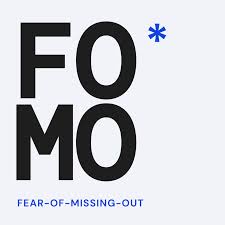
- FOMO (Fear of Missing Out) & Urgency: People are driven to act when they feel they might miss a great opportunity. CTAs that create a sense of urgency can spur immedi (Effective Call-to-Action Strategies for Paid Advertising| NMQ Digital)L174-L182】. For example, “Only 5 spots left for our free home-buying workshop – RSVP now!” uses scarcity (limited spots) to encourage sign-ups. In a video context, you might say, “Don’t miss out on this list of off-market properties; download it now because it’s updated monthly and you’ll want the latest one.” Even subtle urgency like “now,” “today,” or setting a soft deadline (“this week,” “before prices change”) can motivate. Use urgency honestly – e.g., if you truly have a limited-time offer (perhaps a free consultation slot or a webinar date), highlight that. If not, you can manufacture gentle urgency by tying to time (“spring market guide – get it now as you plan for spring”). FOMO also works with content: like the pinned comment example, teasing something amazing at the end of the video triggers viewers’ fear of missing something cool. In CTAs, FOMO could be “Be the first to know about new listings – subscribe and you’ll get insider access.” That implies if they don’t subscribe, they miss insider info.
- Social Proof: People tend to do what others have done, especially if those others benefited. You can incorporate social proof into CTAs by referencing how many others have taken this action or by using testimonials. For instance, “Join over 200 happy subscribers who get our market updates” or “Download the guide that hundreds of local homeowners have used to s (Effective Call-to-Action Strategies for Paid Advertising| NMQ Digital)L185-L193】.” If you have a success story, mention it: “Last month, 50 people requested this report – and we helped several find homes thanks to that info. Get yours too.” Even something like “Our clients LOVE this checklist” adds social proof value. When viewers see evidence that others trust you or value your offering, it reduces the risk in their mind of taking (Effective Call-to-Action Strategies for Paid Advertising| NMQ Digital)L185-L193】. Social proof can also be conveyed visually (e.g., showing an actual number of downloads) or through awards/badges (“Voted #1 agent – contact me to see why!” – though humblebrag carefully). In a subtle way, your subscriber count on YouTube itself is social proof; as it grows, mentioning “subscribe” next to “X subscribers” is inherently more compelling. But even new channels can use phrases like “popular” or “fan-favorite video” in CTAs to hint that others are already engaging.
- Reciprocity: This principle is huge in lead magnets. Reciprocity means if you give something, people feel a psychological urge to (Effective Call-to-Action Strategies for Paid Advertising| NMQ Digital)L189-L197】. By freely giving valuable information (videos themselves, and especially a free PDF or consultation), you create a subtle obligation. The viewer might feel, “They’ve been so helpful; the least I can do is subscribe or reach out.” While you never want to guilt-trip someone, you can encourage this feeling by genuinely delivering value first. One way to phrase a CTA that invokes reciprocity is to frame the free offer as a gift: “I want you to have this” or “I made this for you.” The viewer subconsciously notes that you invested effort for them, increasing the chance they’ll return the favor by signing up or contacting. Another tactic: “I’ve shared my top tips today – if you learned something new, do me a favor and hit the Like button”. You gave tips, they give a like; it’s a small reciprocation. Reciprocity is also why asking for feedback or to “let me know if it helped” can work – people reciprocate by engaging. Overall, lead with generosity and viewers will be more inclined to follow your CTAs out of appreciation.
- Exclusivity: People gravitate toward things that seem exclusive or tailored for a select group. Use language that makes your CTA action feel like joining a VIP club. For example: “Subscribe to become a VIP member of my channel – you’ll get insider info weekly” or “Download our exclusive neighborhood guide (we normally only share this with clients!).” Words like “exclusive,” “insider,” “VIP,” “private,” “members-only” add allure. You can structure offers to be exclusive: maybe a private Facebook group for your subscribers or an email list that gets “exclusive market predictions.” Even if it’s not truly gated, framing it as special access triggers a desire to be included. As mentioned earlier, swapping “Subscribe” with a phrase like “Join the insiders” or “Join the community” leverages exclusivity and (How to create effective YouTube CTAs – SocialBee)L499-L507】. Just ensure you deliver on the exclusive feel (e.g., actually provide those insider tips, etc.). This principle plays on our innate tendency to value things that are not available to everyone.
- Clarity and Simplicity: This isn’t a flashy emotional trigger, but it’s psychological in that the human brain avoids complex (Effective Call-to-Action Strategies for Paid Advertising| NMQ Digital)L195-L199】. If your CTA is too complicated (e.g., “Go to our website, then find the resources tab, then fill out the form for a quote”), most will not bother. The easier and clearer you make the action, the better the conversion. Use simple language and one-step actions if possible. “Click below” – they click and immediately see the signup. Or “Call now” – the number is right there. A clear CTA reduces mental friction. Also, be specific: “Text ‘INFO’ to 12345 for details” is straightforward. In real estate, sometimes agents say things like “to discuss your real estate goals, reach out.” That’s polite, but a more concrete CTA might be “email me at [address] for a free 15-minute strategy session.” Specific offer, specific method. The viewer doesn’t have to figure out what to say or why to reach out – you already defined it. So, clarity in what they get and how to get it will push more people through. Overloading CTAs (too many choices) is the opposite of simplicity and can cause decision (Effective Call-to-Action Strategies for Paid Advertising| NMQ Digital)L197-L200】, so keep it simple per principle (one form, one click, one ask at a time).
- Authority: People tend to follow advice from an expert or figure of (Effective Call-to-Action Strategies for Paid Advertising| NMQ Digital)L179-L187】. As a real estate professional, you can project authority by mentioning credentials or experience in a subtle way around your CTA. For instance, “Download my broker-approved home prep checklist” or “As a certified pricing strategy advisor, I’m offering free home value analyses – request yours.” You’re essentially saying “I’m qualified, so my CTA is worth your trust.” Be careful to not come off as braggy or too formal on YouTube (which is a casual platform), but a little nod to your expertise can reduce hesitation. Even quoting a stat or law can boost perceived authority: “I’ve negotiated 100+ deals – trust me, you’ll want these tips, so get the guide below.” Authority can also be borrowed: “Our guide includes tips from top stagers and inspectors.” Aligning with known authoritative sources (if applicable) adds weight. The idea is to assure viewers that by taking your CTA offer, they’re in expert hands.
- Emotion and Storytelling: Beyond the classic principles, don’t forget that buying or selling a home is emotional. CTAs that tap into emotions can be powerful. For example, fear/relief: “Don’t risk losing money on your sale – book a consult and I’ll make sure you’re on the right track” (plays on fear of a bad outcome, with you providing relief/help). Excitement/aspiration: “Ready to find your dream home? Subscribe and let’s do this journey together!” appeals to the excitement of homeownership. Belonging: we covered with exclusivity/belonging to a community. Curiosity: “Ever wonder what $1 million buys here? Check out more tours – subscribe!” appeals to curiosity and voyeuristic interest common in real estate viewers. Think about the emotional state of your viewer and what might spur them: a frustrated buyer needs hope and guidance (CTA: get help), a casual Zillow surfer might need intrigue to engage more (CTA: see something special). Incorporating the right tone – whether reassuring, urgent, or inspiring – aligned with those emotions can improve CTA effectiveness.
In practice, a great CTA often combines several of these principles. Example: “🏠 Limited Offer: Get our exclusive 2024 Market Forecast report (free for subscribers only). 200+ homeowners have already grabbed it – don’t be the one who misses out! Download now from the link below.” This one sentence incorporates exclusivity (free for subscribers only), social proof (200+ homeowners), FOMO (don’t miss out), and urgency (limited offer), plus a clear action (download now). You wouldn’t use all those in every CTA, but it shows how they can work together.
Use these psychological levers ethically. The goal is to genuinely help viewers while nudging them to take actions beneficial to them (and to your business). Avoid manipulation or false claims, which can backfire and harm your credibility. When done right, applying psychology in CTAs simply means presenting your value in a way that resonates deeply and spurs viewers to take that next step with you.
Conclusion & Next Steps
Effective CTAs are the bridge between viewers enjoying your video and becoming your client or loyal follower. For real estate agents on YouTube, this means every video – whether it’s a home tour, market update, or how-to guide – should end (and/or middle) with a clear pathway for the viewer: what should they do next? By prioritizing lead-capturing CTAs like downloadable guides, free consultations, or email list sign-ups, you turn engaged viewers into tangible leads you can nurture off YouTube. Following that up with subscriber CTAs builds your channel momentum, ensuring your content (and CTAs) reach more people over time.
To implement these insights immediately, here’s a quick actionable summary:
- Audit your last few videos: Did you include CTAs? Were they clear and compelling? Identify one lead-magnet CTA you can insert if not.
- Choose a lead magnet: If you don’t have one, create a simple one (checklist, PDF, etc.) that aligns with common viewer needs. Add its link and mention in your next video.
- Script your CTA: Write out a 1-2 sentence CTA for your next video. Use an imperative verb and a benefit. Practice saying it naturally.
- Add visual support: Design a quick end screen or on-screen text for that CTA. Also, customize your video description with the CTA at the top, and prepare a pinned comment.
- After publishing, monitor analytics: Check how many clicked or converted, and refine if needed for the following video.
Remember, consistency is key
Apply CTAs to every piece of content in some form – even a short YouTube Short or a community post can have a call-to-action (like “follow for more” or a comment prompt). Over time, these small steps compound: you’ll collect emails, schedule appointments, and grow a subscriber base that fuels itself.
Lastly, always keep the viewer’s perspective in mind. Make them feel valued, not marketed to. If your CTAs consistently offer help, insight, or opportunity, viewers will come to trust you and even look forward to your end-of-video pointers. You’ll transform your YouTube channel from just an educational platform into a lead-generating engine for your real estate business.
By employing data-driven tweaks, real-life examples from successful peers, best practices in every format, and a bit of psychology, you can dramatically increase the conversion power of your YouTube CTAs. So start implementing these strategies on your next upload – and watch as more viewers click, subscribe, download, and ultimately reach out to work with you. Good luck, and happy filming!
Ready to schedule a Call?
Start implementing these strategies on your next upload – and watch as more viewers click, subscribe, download, and ultimately reach out to work with you. Good luck, and happy filming!